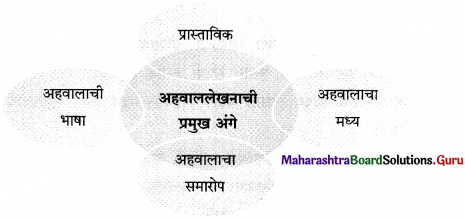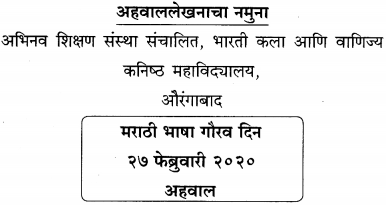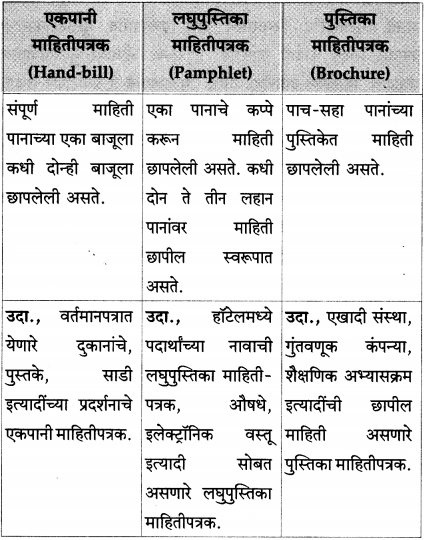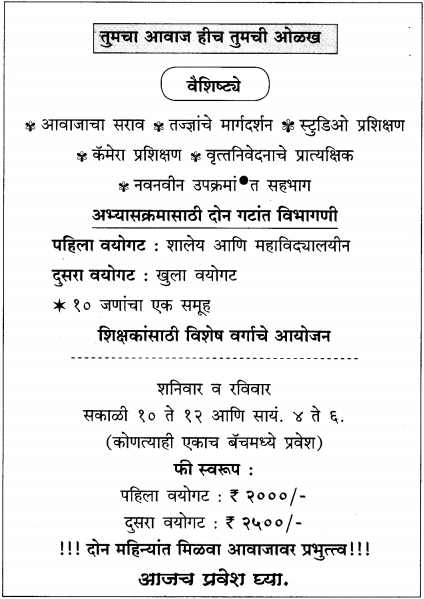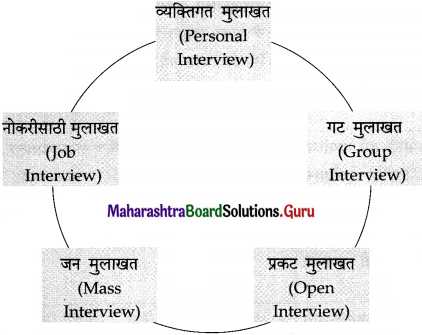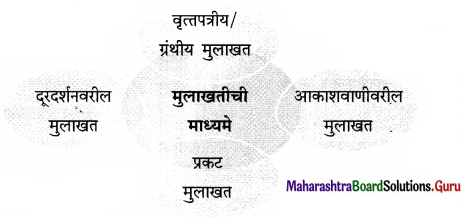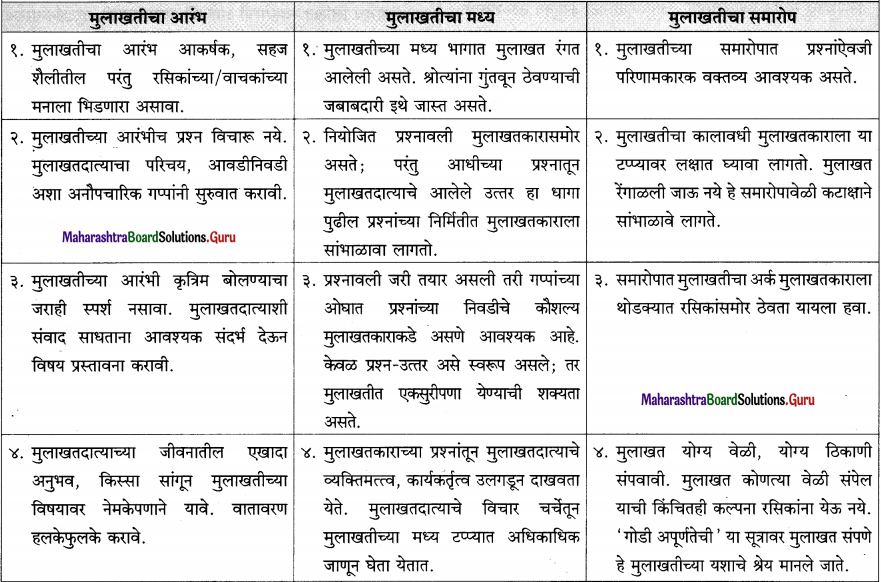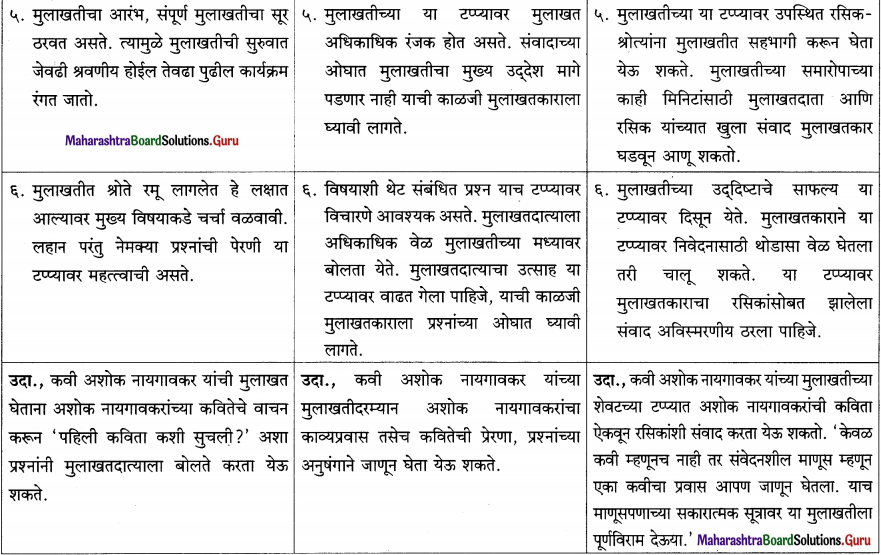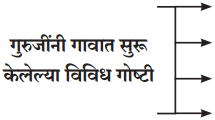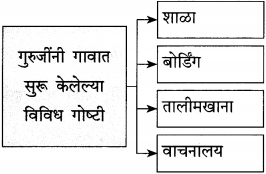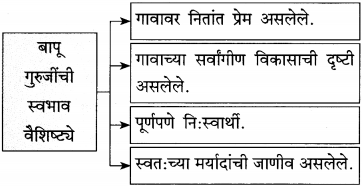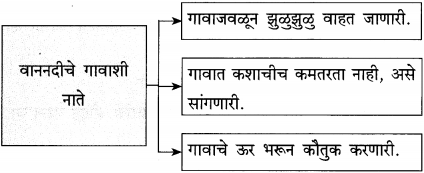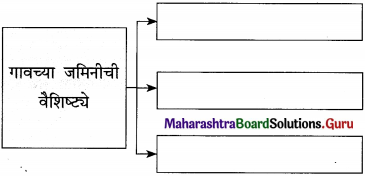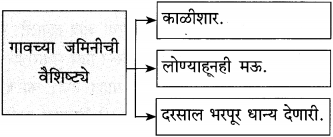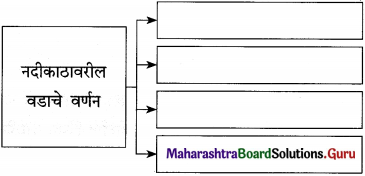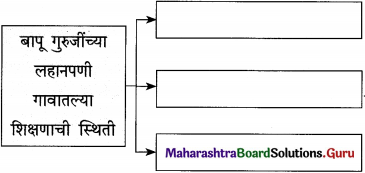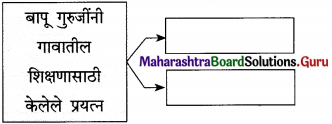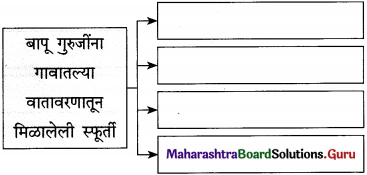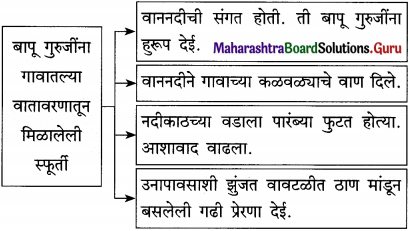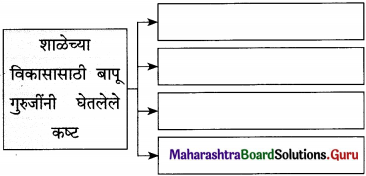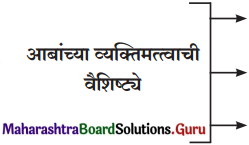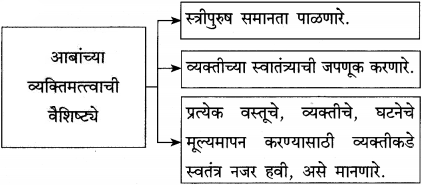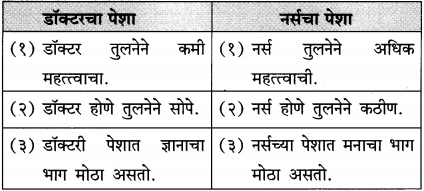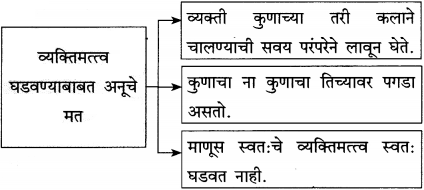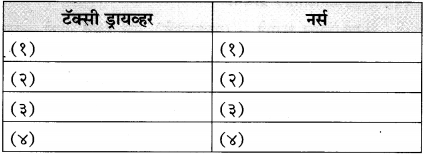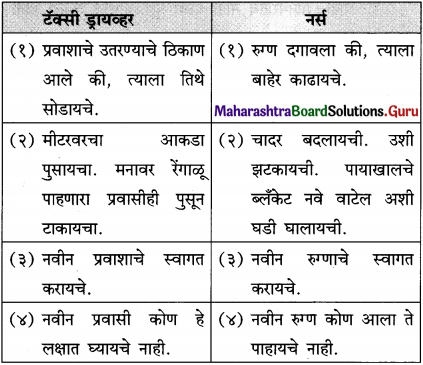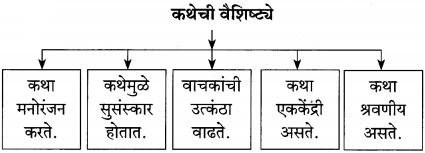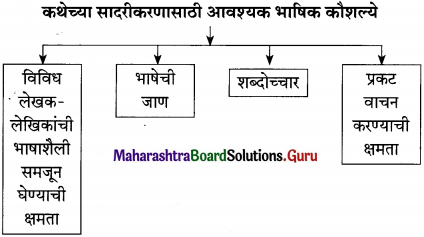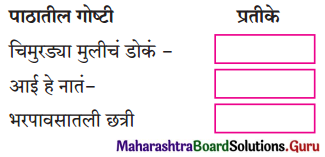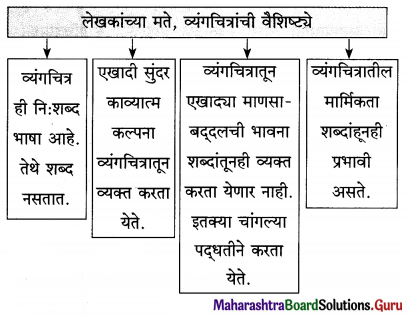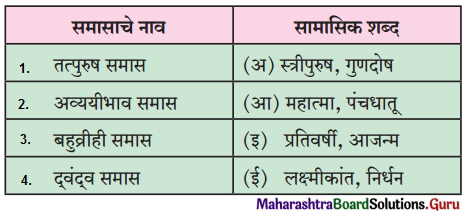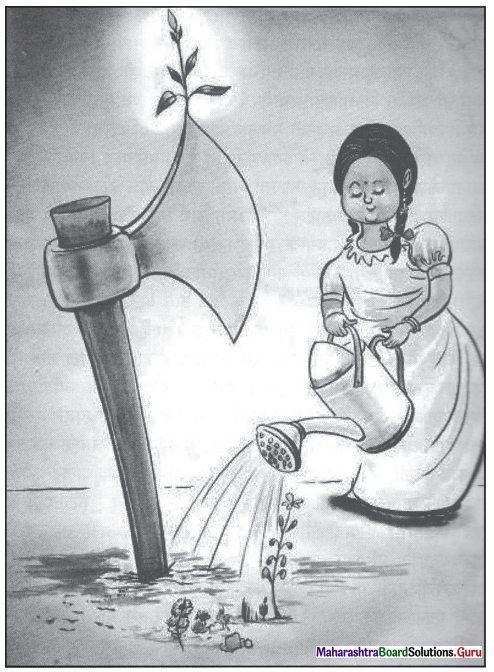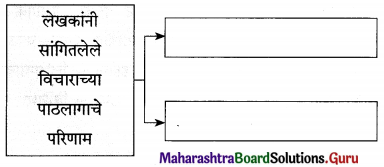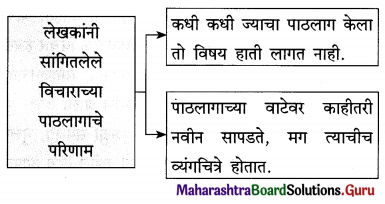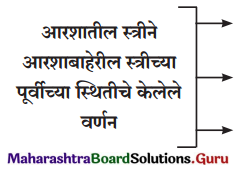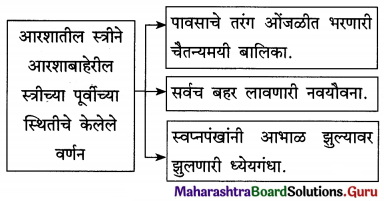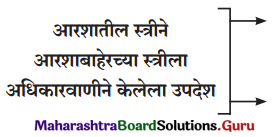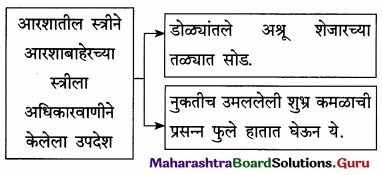Balbharti Maharashtra State Board Marathi Yuvakbharati 12th Digest Bhag 4.4 वृत्तलेख (फिचर रायटिंग) Notes, Textbook Exercise Important Questions and Answers.
12th Marathi Bhag 4.4 Exercise Question Answer Maharashtra Board
वृत्तलेख (फिचर रायटिंग) 12 वी मराठी स्वाध्याय प्रश्नांची उत्तरे
12th Marathi Guide Chapter 4.4 वृत्तलेख (फिचर रायटिंग) Textbook Questions and Answers
कृती
1. वृत्तलेख म्हणजे काय ते स्पष्ट करा.
उत्तर :
मानवी जीवन बातम्यांनी वेढलेले आहे. बातमी वाचली वा सांगितली, तरी वाचकांच्या मनातील उत्सुकता संपत नाही. बातमीत वस्तुनिष्ठ माहिती असते. घडलेली घटना जशीच्या तशी सांगितली जाते. परंतु घटनेच्या भोवताली असलेल्या अनेकविध कंगोऱ्यांचा वेध ज्या लेखनातून घेतला जातो, त्याला वृत्तलेख असे संबोधले जाते. बातमीत ज्या बाबी निदर्शनास येत नाहीत, त्या शोधून रंजक, नावीन्यपूर्ण पद्धतीने वृत्तलेखात मांडल्या जातात. वृत्तलेखाला इंग्रजीत फिचर असे म्हणतात. फिचर या शब्दाचा ऑक्सफर्डच्या शब्दकोशातील अर्थ आहे, ‘बातमीपलीकडचे खास असे काही, आकर्षक असे काही.’
म्हणजेच बातमी ज्या घटनेविषयी आहे, त्याचे तपशील वाचकांपर्यंत पोहोचवण्याचे काम वृत्तलेख करीत असतात. वाचकांच्या मनात बातमीविषयी उत्कंठा वाढवणे, माहिती देणे, ज्ञान देणे, वृत्तलेखाचे महत्त्वाचे कार्य असते. वृत्तलेखाचा आशय, विषय, मांडणी, शैली वाचकांच्या अभिरुचीला साजेशी असते. वृत्तलेख बातमीचे आस्वादनीय रूप असते.
![]()
2. बातमी आणि वृत्तलेख यातील फरक स्पष्ट करा.
उत्तर :
‘जे जे आपणासी ठावे, ते ते इतरांसी सांगावे’ या उक्तीनुसार मनुष्य जीवन जगत असतो. माहिती मिळवणे आणि ती इतरांना सांगणे मनुष्य स्वभावाचे महत्त्वाचे वैशिष्ट्य म्हणता येते. बातमी हा आपल्या आयुष्यातला अपरिहार्य घटक बनला आहे. बातमीत घडलेली घटना जशीच्या तशी सांगण्यावर विशेष लक्ष असते. वस्तुनिष्ठता हा बातमीचा विशेष मानला जातो. लोकजागृती, लोकशिक्षण हे बातमीत महत्त्वाचे असते. बातमीत ‘मी’ असत नाहीत. घटनेचे वास्तवदर्शी रूप बातमी दाखवत असते. बातमी एखादया घटना/प्रसंगाचे दर्शनी रूप नजरेसमोर उभे करू शकते.
वृत्तलेख बातमीच्या पलीकडे असणारी बातमी मांडण्याचा प्रयत्न करीत असतो. बातमीत न आलेली नावीन्यपूर्ण, रंजक माहिती वृत्तलेखात वाचावयास मिळते. बातमीतील घटनेमागे असणारे सूक्ष्म धागेदोरे शोधण्याचा प्रयत्न वृत्तलेखात केला जातो. वृत्तलेख बातमीच्या पायावर उभा असला, तरी वृत्तलेखाचे रूप लालित्यपूर्ण असते. काल्पनिकता नसली तरी बातमीतील अस्पर्शित नोंदी विस्तृतपणे चित्रित केल्या जातात.
3. वृत्तलेखाचे प्रकार लिहून, कोणत्याही एका प्रकाराविषयी सविस्तर माहिती लिहा.
उत्तर :
वृत्तलेखाचा विषय, मांडणी यानुसार वृत्तलेखाचे काही प्रकार पाहायला मिळतात. ते असे :
(१) बातमीवर आधारित वृत्तलेख (२) व्यक्तिचित्रणात्मक वृत्तलेख (३) मुलाखतीवर आधारित वृत्तलेख (४) ऐतिहासिक स्थळांविषयी वृत्तलेख (५) नवल, गूढ, विस्मय यांवर आधारित वृत्तलेख. या सर्व प्रकारांमधील व्यक्तिचित्रणात्मक वृत्तलेख हा एक महत्त्वाचा प्रकार आहे. या प्रकारात एखादया विशिष्ट क्षेत्रातील नामवंत, उल्लेखनीय कामगिरी केलेल्या व्यक्तीच्या कार्यप्रवासावर लिहिले जाते. एखादया क्षेत्रात काम करीत असताना त्या व्यक्तीच्या जीवनात आलेले अनुभव, यश, अडचणींचा केलेला सामना, संघर्ष, उपक्रम, विक्रम इत्यादींसंदर्भात विस्ताराने लिहिले जाते.
या प्रकारचे वृत्तलेख औचित्य साधून लिहिले जातात. पुरस्कार, जयंती, पुण्यतिथी, जन्मशताब्दी यांसारख्या प्रसंगी व्यक्तिचित्रणात्मक वृत्तलेख लिहिले जातात. काही वेळा त्या व्यक्तिसंबंधाने झालेले पूर्वीचे लेखन, त्या व्यक्तीने अन्य लोकांबद्दल केलेले लेखन, त्या व्यक्तीसोबत काम केलेल्या अन्य व्यक्तींचे अनुभव, त्या व्यक्तीच्या सहकाऱ्यांकडून मिळवलेली वैशिष्ट्यपूर्ण माहिती इत्यादींचाही वृत्तलेख लिहिताना उपयोग होतो. केवळ आकडेवारी, सनावळ्या यांना या लेखात फारसे महत्त्व नसते. त्या व्यक्तीची जीवनशैली, वेगळेपण, सवयी अशा व्यक्तिगत जीवनाला स्पर्श करणाऱ्या बाबी महत्त्वाच्या ठरतात.
या प्रकारच्या लेखात व्यक्तीच्या जीवनातील भावनिक गोष्टींना अधिक महत्त्व असते.
![]()
4. ‘वृत्तलेख लिहिताना विचारात घ्यावयाच्या बाबी लिहा.
उत्तर :
वृत्तलेख वाचकांच्या जिज्ञासापूर्तीसाठी महत्त्वाची भूमिका बजावत असतो. बातमीत जे अस्पर्शित आहे, ते शोधून त्याचा सविस्तर आढावा वृत्तलेख घेत असतो. वाचक नेहमीच वर्तमानपत्रीय लेखनात मूलभूत घटक ठरला आहे. वृत्तलेखात वाचकाची अभिरुची प्राधान्याने लक्षात घेतली जाते. वृत्तलेखात तात्कालिकता हा मुद्दाही लक्षात घेतला जातो. वृत्तलेख नैमित्तिक असतो. वृत्तलेखाचे कारण लक्षात घेऊन वाचक वृत्तलेख वाचत असतो. वृत्तलेखाच्या आराखड्यातून वृत्तलेखाचे वेगळेपण अधोरेखित करता येते. यासाठी वृत्तलेखाची मांडणी करताना वेगळेपणाचा विचार करणे गरजेचे असते.
वृत्तलेखाच्या आरंभापासून ते शेवटच्या वाक्यापर्यंत वृत्तलेखाने वाचकाची उत्सुकता टिकवून ठेवणे आवश्यक असते. यासाठी वृत्तलेखाचा विषय, मध्यवर्ती कल्पना, शीर्षक, तक्ते, नकाशा, छायाचित्र या सर्वांचा विचार करावा लागतो. वृत्तलेखाचा मजकूर जेवढा उत्तम हवा असतो, त्यासोबतच समर्पक छायाचित्रांची यथोचित मांडणी महत्त्वाची असते. वाचकांचे लक्ष वेधण्यासाठी मांडणीचा वाटा महत्त्वाचा असतो.
वृत्तलेखात शैली या घटकावरही लक्ष दयावे लागते. वृत्तलेखाचा आरंभ, मध्य आणि समारोप यांतून वृत्तलेखनातून अपेक्षित हेतू साध्य होणे आवश्यक असते. वृत्तलेखाच्या भाषेचा विचारही अपेक्षित असतो. सरळ, साधी, मनाला भिडणारी भाषा असणे आवश्यक असते. उत्तम वृत्तलेखासाठी या महत्त्वपूर्ण बाबी विचारात घेणे आवश्यक असते.
5. थोडक्यात उत्तरे लिहा.
प्रश्न अ.
वृत्तलेखाची गरज
उत्तर :
बातमी वाचली तरी वाचकांच्या मनातील बातमीविषयीची उत्सुकता संपत नाही. बातमी घडलेल्या घटनेचे वास्तव चित्रण करीत असते. घटना समजून घ्यायची असेल, तर बातमीत न आलेल्या बाबींचा शोध घेणे आवश्यक असते. वृत्तलेख बातमीच्या आतील बातमी उलगडून दाखवण्याचे काम करीत असते. वृत्तलेखातून बातमीच्या मुळापर्यंत पोहोचणे शक्य होते. घडून गेलेल्या वा घडू पाहणाऱ्या घटनेशी वृत्तलेखाचा संबंध असतो. वृत्तलेख वाचकांना आनंद देणारा, माहिती देणारा असतो. वाचकांच्या विचारांना धक्का देण्याची ताकद वृत्तलेखात असते. बातमीचा आनंद घेण्यासाठी वृत्तलेखाची मदत होत असते. वृत्तलेख वाचकांच्या भावनांची दखल घेत असतो. वाचकांचे समाधानही वृत्तलेख वाचनातून होत असते.
![]()
प्रश्न आ.
वृत्तलेखाचे स्रोत
उत्तर :
प्रसारमाध्यमांवर प्रकाशित, प्रसारित होणाऱ्या बातम्या पाहिल्यानंतर लेखकाच्या मनात वृत्तलेखाचे बीज तयार होत असते. बातमीच्या अनुषंगाने असणारे संदर्भ, गोष्टी, मुलाखती या बाबींचा पाठपुरावा केला की वृत्तलेखाला आवश्यक वातावरण निर्माण होत असते. बातमी हा वृत्तलेखाचा महत्त्वाचा स्रोत आहे. बातमीतल्या घटनेचे स्वरूप आणि परिणाम समजून घेण्यासाठी वृत्तलेख दिशादर्शक ठरू शकतो. पत्रकारितेच्या क्षेत्रात अनेक व्यक्तींशी संपर्क होत असतो. त्यांच्याशी होणाऱ्या संवादातून वृत्तलेखाचे विषय मिळू शकतात. पत्रकारितेत नेहमी बातमी सहज उपलब्ध होतेच असे नाही. बऱ्याचदा बातमी शोधावी लागते, त्यातील छुपे कंगोरे शोधावे लागतात. त्यासाठी बातमीशी निगडित अनेक लोकांशी संभाषण करावे लागते. यातून वृत्तलेखाला बीज सहज मिळू शकते. वृत्तलेखासाठी बारकाईने निरीक्षण अपेक्षित असते. सभोवताली घडणाऱ्या घटनांचे निरीक्षण करता येणे, त्यातील बातमी शोधून वृत्तलेखाचा विषय निर्माण करता येऊ शकतो.
प्रश्न इ.
वृत्तलेखाची भाषा
उत्तर :
वृत्तलेख बातमीवर आधारित असला, तरी बातमीपेक्षा अधिक सांगण्याचा प्रयत्न करीत असतो. वृत्तलेख लिहिताना वाचकांच्या अभिरुचीचा विचार वृत्तलेखात प्राधान्याने केला जातो. सर्वसाधारण वाचक वर्ग नजरेसमोर ठेवून वृत्तलेखाच्या विषयांची निवड केली जाते. वृत्तलेखाची भाषा देखील सहज, सोपी चटकन ५ विषय लक्षात येईल अशी असणे अपेक्षित असते. भाषेचे स्वरूप सरळ असले, तरी परिणामकारकता असणे गरजेचे असते. वृत्तलेख वाचकांची उत्सुकता वाढवत असल्याने भाषा मनाला भिडणारी असावी. वृत्तलेखातील मजकुरातील शब्दबंबाळपणा टाळणे आवश्यक असते. लहान लहान वाक्यरचना, बोलीभाषेतील शब्द असतील, तर विषय समजण्यास सोपे होते. विषयाचा हेतू लक्षात घेऊन वाचकांची जिज्ञासा शमली जावी, अशा भाषेत वृत्तलेखाची मांडणी असणे अभिप्रेत असते.
प्रश्न ई.
वृत्तलेखाची वैशिष्ट्ये
उत्तर :
अनेकदा एखादया बातमीच्या वाचनानंतर वाचकाच्या मनात त्या बातमीविषयी कुतूहल निर्माण होते. बातमीच्या स्वरूपानुसार घटनेमागील घटना बातमीत सांगितली जात नाही. अशा वेळी वाचकांच्या उत्सुकतेसाठी वृत्तलेख लिहिले जातात. वृत्तलेख तात्कालिक असतात. घटनेचे निमित्त वृत्तलेखाच्या पाठीशी असते. वृत्तलेख घडून गेलेल्या घटनेबद्दल बोलत असते. बातमीत घटनेचा तपशील देता येत नाही. वृत्तलेखात बातमीतील अदृश्य दुवे प्रकाशझोतात आणण्याचा प्रयत्न केला जातो. वृत्तलेखाचा विषय नेहमी ताजा असतो. वृत्तलेखाला ‘धावपळीतले साहित्य’ असेही म्हणतात. वाचकांना बातमीचा आस्वाद घेण्यासाठी वृत्तलेखाची निर्मिती होत असते.
![]()
6. वर्तमानपत्रातील एखादा वृत्तलेख मिळवा आणि त्यात आढळलेली वैशिष्ट्ये लिहा.
उत्तर :
दि. ४ फेब्रुवारी २०१२ रोजी लोकसत्ता या वर्तमानपत्रातील चतुरंग पुरवणीत प्रकाशित झालेला वृत्तलेख वाचला. मीना वैशंपायन यांनी लेखिका दुर्गा भागवत यांच्या आठवणींना उजाळा देण्यासाठी सदर वृत्तलेख लिहिला आहे. दहा फेब्रुवारी हा दुर्गाबाई भागवतांचा जन्मदिवस. या निमित्ताने ‘मुक्ता’ या शीर्षकाने हा वृत्तलेख लिहिला आहे. दुर्गाबाई भागवतांची वैचारिक भूमिका, स्त्री सक्षमीकरणाचे विचार आणि दुर्गाबाई भागवत यांच्यातील स्त्री जाणिवांचा वेध घेणे हा वृत्तलेखाचा मध्यवर्ती विषय आहे. वृत्तलेखाचा आरंभ १९७५ च्या काळातील आणीबाणीचा संदर्भ आणि दुर्गाबाई भागवतांची परखड भूमिका या संदर्भांनी केला आहे.
१९७५ ची आणीबाणी, त्याच वर्षी दुर्गाबाई भागवत यांचे अखिल भारतीय मराठी साहित्य संमेलनाचे अध्यक्षपद आणि १९७५ ला घोषित झालेले जागतिक महिला वर्ष यांचे संदर्भ वृत्तलेखाच्या पहिल्या टप्प्यात लेखिकेने नमूद केले आहेत. हे वाचत असताना वाचक म्हणून उत्सुकता हळूहळू वाढत जाते. स्त्रीस्वातंत्र्य, सबलीकरण, स्त्री-पुरुष समानता याबद्दल दुर्गाबाई भागवतांच्या विचारांचे विश्लेषण लेखिकेने विस्तृतपणे केले आहे. स्त्री मूलतः सक्षम आहे हे सांगताना दुर्गाबाई भागवत यांनी लिहिलेल्या ‘विदयेच्या वाटेवर’ या लेखाचा संदर्भ वृत्तलेखिकेने वृत्तलेखात सोदाहरण सांगितला आहे.
सदर लेखाचा व्यक्तिचित्रणात्मक या वृत्तलेख प्रकारात समावेश करता येतो. दुर्गाबाई भागवत यांच्यातील ‘मुक्त स्त्रीत्वाचा दृश्य आविष्कार’ संपूर्ण वृत्तलेखात लेखिकेने समर्थपणे शब्दरूपात उभा केला आहे. वृत्तलेखाचा आरंभ, मध्य आणि समारोप या तीन पातळ्यांवर वृत्तलेख यशस्वी होतो. वृत्तलेखाची भाषा प्रवाही आणि परिणामकारक आहे. दुर्गाबाई भागवतांचे संयत व्यक्तिमत्त्व वाचकांसमोर उलगडून दाखवण्यासाठी तेवढ्याच संयतपणे भाषेचा अवलंब केला आहे.
7. बातमीवर आधारित वृत्तलेख लिहिताना करावयाची तयारी तुमच्या शब्दांत लिहा.
उत्तर :
वृत्तलेखाची प्रकृती बातमीवर आधारलेली असते. बातमी वस्तुनिष्ठपणे घटना सांगते. परंतु घटनेपलीकडचे दृश्य वृत्तलेखात चित्रित करायचे कौशल्यपूर्ण काम वृत्तलेखकाचे असते. एखादया घटनेत वेगळेपण असले तरच बातमी बनत असते. अशा बातमीवर आधारित वृत्तलेख लिहिताना सर्वप्रथम बातमीचा विषय समजून घेणे अपेक्षित असते. बातमीतली घटना, तिचे अदृश्य दवे शोधण्यासाठी बातमीतील घटनेचा सूक्ष्मपातळीवर विचार करावा लागेल.
![]()
घटनेमागचे कारण आणि परिणाम यांची यथोचित सांगड घालून तटस्थपणे घटनेचा वेध घ्यावा लागेल. बातमीत छुप्या असणाऱ्या घटकांचा शोध घेऊन त्यावर प्रकाश टाकणे, पूरक मुद्दे अधोरेखित करणे अशा बाबींवर प्राधान्याने काम करावे लागेल. बातमीतील मुद्दयांचे सुस्पष्ट भाषेत विश्लेषण करण्याचा प्रयत्न करणे आवश्यक असल्याने बातमीच्या परिघात येणाऱ्या महत्त्वाच्या घडामोडींसंदर्भात तज्ज्ञांशी सल्लामसलत करणे उचित ठरेल. बातमीतील तळ गाठून माहिती कागदावर आणली तर वाचकांची उत्सुकता शमवता येईल.
वृत्तलेख (फिचर रायटिंग) प्रस्तावना
‘जे जे आपणासी ठावे, ते ते इतरांसी सांगावे’ या उक्तीनुसार माणूस जीवन जगत असतो. माहिती मिळवणे आणि ती इतरांना सांगणे हे मानवी स्वभावाचं महत्त्वाचं वैशिष्ट्य म्हणता येते. जे ‘सांगणे’ केवळ स्व-रक्षणासाठी होते, त्याचा प्रवास हळूहळू व्यक्त होण्यापर्यंत येऊन पोहोचला. अभिव्यक्तीचे प्रभावी माध्यम म्हणून वृत्तपत्रांचा स्वीकार मोठ्या प्रमाणावर केला जाऊ लागला. मानवी जीवन बातम्यांनी व्यापले गेले. वर्तमानपत्र, आकाशवाणी, दूरदर्शन यांसारख्या प्रसारमाध्यमांसोबत नव्याने स्थिर झालेल्या समाजमाध्यमांत आपण बातम्या ऐकत आणि पाहत असतो.
बातमी औत्सुक्य निर्माण करते. बातमी वाचली तरी वाचकांच्या मनात बातमीतल्या घटनेबद्दल अधिकाधिक जिज्ञासा निर्माण होत असते. बातमीत वस्तुनिष्ठता महत्त्वाची असल्याने जे घडले तसेच बातमीत सांगितले जाते. बातमीत न सांगितली गेलेली नावीन्यपूर्ण, रंजक माहिती आणि सूक्ष्म धागेदोरे वाचण्यासाठी वाचकांना वृत्तलेखाचा (फिचर रायटिंगचा) उपयोग होतो.
वृत्तलेख (फिचर रायटिंग) वृत्तपत्र अर्थ आणि स्वरूप :
- बातमीपत्रात जसे घडले तसे सांगितले जाते. बातमीपलीकडे असलेला तपशील वाचकांना देणे आवश्यक असते.
- इंग्रजीत याला ‘फिचर’ असे म्हणतात. बातमी ज्या घटनेशी निगडित आहे तिचे तपशील वाचकांपर्यंत पोहोचवणे गरजेचे असते.
- या गरजेतूनच वृत्तलेख या लेखनप्रकाराचा जन्म झाला आहे.
- फिचर म्हणजे नॉन न्यूज असे रूढ असले, तरी वृत्तलेखाचा संबंध बातमीशी असतो.
- घडून गेलेल्या घटनेशी अथवा घडू पाहणाऱ्या घटनेशी वृत्तलेखाचा घनिष्ठ संबंध असतो.
- वृत्तलेखाला बातमीचा आधार असावा लागतो. निमित्त असावे लागते.
- वृत्तलेखाला ‘धावपळीचे साहित्य’ असेही म्हणतात. वृत्तलेख तातडीचा असतो.
- वृत्तलेख बातमीमागची बातमी सांगत असतो. वृत्तलेखात रंजकता असली, तरी कल्पकतेला फारसा वाव नसतो.
- अचूकता वृत्तलेखात महत्त्वाची असते.

- वृत्तलेख बातमीवर आधारित असला, तरी लेखनकृतीत स्वतंत्र असतो. मजकूर आकर्षक आणि वैशिष्ट्यपूर्ण असणे हे वृत्तलेखाचे वैशिष्ट्य असते.
- बातमीचा आस्वाद घेण्यासाठी वृत्तलेखाचा उपयोग होतो. वृत्तलेखात वाचकांच्या भावनांचा विचार करून लेखन केलेले असते.
- वृत्तलेखात वाचकांचे समाधान हा घटकही महत्त्वाचा मानला जातो.
- वृत्तलेखाची भाषा सोपी, ओघवती असावी.
- वाचकांना सहज समजणारी, आपलीशी वाटणारी, वाचकांना खिळवून ठेवणारी, परिणाम साधणारी भाषाशैली असावी.
- वृत्तलेखाचा विषय, आशय, शैली वाचकांना आकृष्ट करणारी असते.
- वाचकांच्या विचारांना धक्का देणारी ताकद वृत्तलेखात असते.
- वृत्तलेखातील माहिती विश्वसनीय असते. मुद्द्यांच्या समर्थनार्थ वृत्तलेखात नकाशे, छायाचित्रे, व्यंगचित्रे, आकडेवारीचा तक्ता वापरला जाऊ शकतो.
- वृत्तपत्रलेखन हे कौशल्यपूर्ण काम आहे. वृत्तलेखन करणास लेखक आपले अनुभव आणि विषयाच्या संदर्भाने असलेली तज्ज्ञता वापरत असतो.
- वृत्तलेखक वाचकांना आनंद देणारा, माहिती, ज्ञान देणारा आणि सर्वांत महत्त्वाचे म्हणजे बातमीपलीकडची बातमी जिवंत करणारा असतो.
| वर्तमानपत्रांचा जन्म पाश्चात्त्य देशात झाल्याने तेथील काही संकल्पना भारतात देखील रुजल्या. त्यापैकी एक म्हणजे फिचर, म्हणजेच वृत्तलेख. ऑक्सफर्डच्या शब्दकोशात ‘फिचर’चा अर्थ ‘It is a non news article in a news paper’ असा देण्यात आला आहे. म्हणजे ‘बातमीपलीकडचे खास असे काही, आकर्षक असे काही.’ |
वृत्तलेखांचे प्रकार :
बातम्यांचा विषय आणि लेखनप्रकारानुसार वृत्तपत्र लेखनाचे पुढील प्रकार –

1. बातमीवर आधारित वृत्तलेख :
- या वृत्तलेखाच्या नावावरूनच त्याचे स्वरूप लक्षात येते. एखादया बातमीच्या संदर्भाने हा वृत्तलेख लिहिलेला असतो.
- वर्तमानपत्रात छापून आलेल्या बातमीचा या प्रकारात नव्याने विचार करणे प्रस्तुत ठरते.
- वर्तमानपत्रातील घटनेत असणारी सर्व माहिती वृत्तलेखात नसते; परंतु बातमीमागची बातमी वाचकांना या प्रकारच्या वृत्तलेखात वाचायला मिळते.
- बातमीवर आधारित वृत्तलेखन करताना बातमीतील घटनेचा सविस्तर आढावा घेणे अपेक्षित असते.
- वर्तमानपत्रातील बातमीत ज्या नोंदी आल्या नसतील, अशा नोंदींवर प्रकाश टाकण्याचे काम या प्रकारच्या वृत्तलेखनात होणे आवश्यक असते. या
- प्रकारच्या वृत्तलेखात बातमीतील मुद्द्यांचे विश्लेषण करणे गरजेचे असते.

- कधी कधी वृत्तलेखकाला बातमी संदर्भातील विशेष तज्ज्ञ व्यक्तींशी बोलून घटनेचा तळ गाठावा लागतो.
- वृत्तलेखकाकडे लेखनासाठी असणारी माहिती स्वतंत्र आणि विश्वसनीय असणे आवश्यक असते.
- या प्रकारच्या वृत्तलेखासाठी विषयाच्या मर्यादा नसतात.
- स्थानिक पातळीपासून ते आंतरराष्ट्रीय पातळीपर्यंत कोणत्याही बातमीवर या प्रकारचे वृत्तलेखन करता येऊ शकते.
- बातमीपेक्षा अधिक काही मिळाल्याचा आनंद वृत्तलेख वाचकांना मिळणे हेही वृत्तलेखकाला ध्यानात घेणे आवश्यक असते.
- उदा., पेट्रोल-डीझेलचा वाढत जाणारा तुटवडा – स्वरूप आणि कारणे, लोकल ट्रेनमधील वाढती गर्दी – कारणे आणि उपाय, ग्रामीण भागातील पशुधनाची घटलेली संख्या व त्याचा समाजजीवनावर होणारा परिणाम इत्यादी.
2. व्यक्तिचित्रणात्मक वृत्तलेख :
- या प्रकारच्या वृत्तलेखात एखादया क्षेत्रात देदीप्यमान कार्य केलेल्या व्यक्तीच्या जीवनाचा आढावा घेतला जातो.
- सामान्य असो की असामान्य कुठल्याही व्यक्तीच्या संघर्षाची दखल या वृत्तलेखात घेतली जाते.
- एखादया क्षेत्रातील यश, त्यासाठी करावा लागलेला संघर्ष, प्रयत्नांची पराकाष्ठा, अडचणींचा केलेला सामना, महत्त्वपूर्ण कृती, उपक्रम, विक्रम या संदर्भातील लेखन या वृत्तलेखात करणे आवश्यक असते.
- व्यक्तिचित्रणात्मक वृत्तलेख बहुतकरून औचित्य साधून लिहिलेले असतात.
- पुरस्कार, गौरव, वाढदिवस, जयंती, पुण्यतिथी, अमृत महोत्सव इत्यादी प्रसंगी या प्रकारचे वृत्तलेख लिहिले जातात.
- व्यक्तिचित्रणात्मक वृत्तलेखात वाचकांपुढे विशिष्ट व्यक्तीचा केवळ जीवनपट उभा करणे अपेक्षित नसते.
- व्यक्तीच्या जीवनाचे अनेक पैलू उलगडून दाखवणे आवश्यक असते.
- अशा वेळी त्या व्यक्तीसंबंधी पूर्वी झालेले लेखन, चरित्र, आत्मचरित्र, सोबत काम केलेल्या व्यक्ती, स्नेहीजन यांच्या मुलाखती अशी विस्तृत माहिती मिळवणे उपयुक्त ठरते.

- या प्रकारच्या लेखनात व्यक्तीच्या आयुष्यातील महत्त्वाच्या तारखा, सनावळ्या, आकडेवारी एवढ्याचीच नोंद करून, परिचयात्मक माहिती लिहून चालत नाही. त्यासाठी त्या व्यक्तीचे विचार, भूमिका, दृष्टिकोन, खास शैली, सवयी इत्यादी बाबींचा सखोल परामर्श घेणे महत्त्वपूर्ण ठरते.
- माहितीतील तांत्रिक बाबींत अधिक न अडकता व्यक्ती जीवनातील भावनिक स्पर्श हे या वृत्तलेखाचे वैशिष्ट्य म्हणता येते. उदा., सिंधुताई सकपाळ, बीजमाता राहीबाई पोपरे, डॉ. श्रीराम लागू इत्यादी.
3. मुलाखतीवर आधारित वृत्तलेख :
- वेगवेगळ्या क्षेत्रातील लोकांच्या प्रसार माध्यमांवर होणाऱ्या मुलाखती लेख स्वरूपात वृत्तपत्रात प्रकाशित केला जातो. त्याला मुलाखतीवर आधारित वृत्तलेख असे संबोधले जाते.
- या प्रकारच्या वृत्तलेखातून विशिष्ट क्षेत्रात कार्याने आपली नाममुद्रा उमटवणाऱ्या व्यक्ती, त्यांचा कार्यप्रवास, महत्त्वपूर्ण संशोधन, मतप्रणाली, त्यांचे कार्यक्षेत्र, यश, अडचणी, अनुभव यांसारख्या ५ मुद्दयांची गुंफण करणे आवश्यक असते.
- कार्यसिध्द व्यक्तींची स्वतःची भूमिका मांडण्याचा प्रयत्न या प्रकारच्या वृत्तलेखात करणे महत्त्वाचे असते. सर्वसामान्य लोक व्यक्तिजीवनातील ज्या गोष्टींपासून अनभिज्ञ आहेत, अशा गोष्टींचा परिचय करून देणे वृत्तलेखाचे प्रधान कार्य असते.
- विशिष्ट व्यक्तीच्या कर्तृत्वाची उंची आणि संबंधित क्षेत्रातील योगदान अधोरेखित करण्याचा प्रयत्न या वृत्तलेखात करणे गरजेचे ठरते. उदा., नामवंत लेखक, गिर्यारोहक, संशोधक इत्यादींच्या मुलाखतीवर आधारित लेख.
4. ऐतिहासिक स्थळांविषयी वृत्तलेख :
- या प्रकारच्या वृत्तलेखात संशोधनात्मक लेखन असते. प्राचीन मंदिरे, लेण्या, स्थळे, गावे इत्यादी संदर्भातील उपलब्ध माहितीच्या आधारे नव्याने माहिती देणारा ऐतिहासिक स्वरूपाचा वृत्तलेख लिहिणे अपेक्षित असते.
- गावे, स्थळे, प्राचीन मंदिरे, वस्तू यांना ऐतिहासिक संदर्भ असतात.
- या वृत्तलेखात अशा ऐतिहासिक संदर्भांना केंद्रस्थानी ठेवून लेखन करणे आवश्यक असते.
- शिलालेख, नाणी, भूर्जपत्रे, ताम्रपट यांच्या इतिहासकालीन रूपाचा बदलत्या काळात नव्याने अर्थ शोधला जात आहे. नवनवीन माहिती समोर येत आहे.
- संशोधक जुन्या माहितीच्या संदर्भात संशोधनात्मक अभ्यासातून एखादया वस्तू किंवा स्थळावर प्रकाशझोत टाकत असतात. या नव्या माहितीच्या संदर्भात वृत्तलेख करणे महत्त्वाचे ठरते.
- लोकसाहित्य, लोककला, लोकसंस्कृती यासंदर्भात वृत्तलेखक विविध क्षेत्रभेटीतून जे जे अनुभवास आले, त्याला अनुलक्षून वृत्तलेखन करू शकतो. ऐतिहासिक स्थळांविषयी वृत्तलेख लिहित असताना इतिहास तज्ज्ञ, त्यांच्याशी विषयानुरूप केलेल्या चर्चा, व्याख्यान, मुलाखती इत्यादीचे साहाय्य घेणे उपयुक्त ठरते.
- या प्रकारच्या वृत्तलेखात आवश्यकतेनुसार नकाशा, चित्रे, छायाचित्रे यांचा वापर करता येऊ शकतो. उदा., शनिवारवाडा, हेमाडपंथीय मंदिराचे शिल्पकाम, अंबरनाथ येथील प्राचीन शिवमंदिर इत्यादी.
5. नवल, गूढ इत्यादींवर आधारित वृत्तलेख :
- एखादी विस्मयकारक घटना, निसर्गातील नवलाई यासंबंधीच्या अनुभवांवर आधारित लेखन या प्रकारच्या वृत्तलेखात केले जाते.
- एखादया परिसरातील निसर्गाच्या आश्चर्यजनक किमया, गूढ, अनाकलनीय गोष्ट, निसर्गातील एखादी लक्षवेधी परंतु चमत्कारिक गोष्टदेखील वृत्तलेखाचा विषय होऊ शकतो.

- या प्रकारच्या वृत्तलेखात माहितीची विश्वासार्हता तपासणे फार महत्त्वाचे असते. उपलब्ध माहितीची शहानिशा करणे, माहितीची पारख करणे, चिकित्सा करणे यांसारख्या बाबी प्राधान्याने विचारात घेणे गरजेचे असते.
- निसर्गातील अनाकलनीय गोष्टी सत्यतेच्या चाचणीतून लेखात मांडणे अतिशय कौशल्यपूर्ण काम असते. वृत्तलेखकाला जबाबदारीने या प्रकारच्या वृत्तलेखाचे लेखन करणे आवश्यक असते.
- कोणत्याही प्रकारची चुकीची अथवा अफवा पसरवणारी माहिती, नोंदी, नकारात्मकता वृत्तलेखातून प्रकट होणार नाही याची काळजी कटाक्षाने या प्रकारच्या वृत्तलेखात घ्यावी लागते.
- उदा., सांगलीत नदीच्या पाण्याची पातळी ५८ फूट, रांजणखळगे, गरम पाण्याचे कुंड इत्यादी. वृत्तलेखांच्या वरील प्रकारांशिवाय सांस्कृतिक कार्यक्रम, लोकरुचीचे कार्यक्रम, खादयसंस्कृती इत्यादी विषयांवरही वृत्तलेख लिहिले जाऊ शकतात.
वृत्तलेखाच्या विषयांचे स्रोत :
प्रसारमाध्यमातील व्यक्तींना सध्या घटनेतही बातमी दिसत असते. वर्तमानपत्रात काम करणाऱ्या व्यक्तींना येणारे अनुभव, प्रवास, भेटणाऱ्या व्यक्ती विविध वर्तमानपत्रातील बातम्या, पुस्तके, नियतकालिके, संकेतस्थळ यांसारख्या विविध साधनांच्या आधारे वृत्तलेखाचे विविध विषय मिळत असतात. वृत्तलेखाच्या विषयांचे काही महत्त्वाचे स्रोत पुढीलप्रमाणे –
1 बातमी :
- वृत्तलेखात बातमीपलीकडची बातमी चित्रित केलेली असते. वर्तमानपत्रात, नियतकालिकात छापील स्वरूपात आलेल्या बातम्या वृत्तलेखाला विषय पुरवत असतात.
- दूरचित्रवाणीवर दाखवली जाणारी एखादी घटना लेखकाच्या मनात वृत्तलेखाचे बीज रुजवत असते.
- बातमीपेक्षा अधिक काही जे बातमीत दडलेले असते, त्याचा शोध वृत्तलेखात घेणे आवश्यक असते.
- बातमीसोबत जोडले असलेले संदर्भ, दुवे, महत्त्वाच्या गोष्टी, मुलाखती यांच्या साहाय्याने बातमीच्या आधारावर वृत्तलेखनाचा मजकूर फुलवता येऊ शकतो.
- कुठल्याही बातमीकडे सूक्ष्मपणे पाहिले, त्यातील बारकावे लक्षात घेतले, तर वृत्तलेखासाठी भूमी तयार होऊ शकते.
- बातमी, बातमीभोवती असणारे विविध कंगोरे, बातमीचे परिणाम यांचा सखोल अभ्यास केला, तर वृत्तलेखासाठी अनेक विषय मिळू शकतात.
- उदा., ‘अभिनेते अमिताभ बच्चन यांना दादासाहेब फाळके हा सन्मानाचा पुरस्कार प्राप्त’ या बातमीच्या आधारे, दादासाहेब फाळके पुरस्काराचे महत्त्व, अभिनेते अमिताभ बच्चन यांचा ५ अभिनयाचा प्रवास, महत्त्वाचे चित्रपट, कौटुंबिक पार्श्वभूमी, अमिताभ बच्चन यांचा जीवनप्रवास इत्यादी मुद्द्यांच्या आधारे व्यक्तिचित्रणात्मक वृत्तलेख लिहिला जाऊ शकतो.

2. व्यक्तिगत अनुभव :
- पत्रकारितेचे क्षेत्र म्हणजे नित्यनवा जिवंत अनुभव असणारे क्षेत्र मानले जाते.
- पत्रकारितेच्या क्षेत्रात वावरणाऱ्या लोकांना रोज नव्या आव्हानात्मक घटना/प्रसंगांना सामोरे जावे लागते.
- बातमी बघताना अनेक अनुभव मिळत असतात. या अनुभवांपैकी काही मूळ बातमीस पूरक ठरतात, तर काही अनुभव लेखकाच्या मनात साठवले जातात. या अनुभवांची शिदोरी लेखकाला वृत्तलेखात उपयोगी पडते.
- या अनुभवांचा पुनरुच्चार एखादया वृत्तलेखात करता येऊ शकतो. गतकाळातील अनुभवात भविष्यातील एखादया वृत्तलेखाची बीजे रुजलेली असतात.
- उदा., ‘आश्रमातील मुलांना शैक्षणिक वस्तूंचे वाटप’ अशा बातमीच्या भोवताली लहान मुलांचे भावविश्व, मुलांचे आश्रमातील जीवन, कुटुंबापासून दूर असल्याची भावना, लहान मुलांची शैक्षणिक, वैचारिक जडणघडण असे कितीतरी बातमीमागचे पैलू लेखकाला दिसू शकतात.
- यासंदर्भाच्या आधारे ‘एकटेपणात अडकलेले बालविश्व’ अशा प्रकारचा वृत्तलेख निश्चितच आकाराला येऊ शकतो.
3. भेटीगाठी/संभाषण :
- पत्रकारिता करणाऱ्या व्यक्तींना नेहमी लोकसंपर्कात राहणे गरजेचे असते. यासाठी व्यवसायाची गरज म्हणून संवादकौशल्य हवे असते. पत्रकारिता करणाऱ्या व्यक्तीला भाषेचे उत्तम ज्ञान असणे आवश्यक असते. लेखनकौशल्यावर प्रभुत्व असावे लागते.
- पत्रकारितेत अनेकदा विविध क्षेत्रातील उच्चपदस्थ अधिकारी ते सामान्य व्यक्ती अशा प्रत्येक घटकातील व्यक्तींशी संवाद साधावा लागतो.
- प्रशासकीय सेवेतील अधिकारी, लोकप्रतिनिधी, विविध कंपन्यांचे व्यवस्थापक, खेळाडू यांच्याशी संभाषण करीत असताना कितीतरी स्थानिक पातळीवरील विषयांपासून ते राष्ट्रीय, आंतरराष्ट्रीय पातळीवरील कितीतरी महत्त्वपूर्ण विषयांवर चर्चा करावी लागते.
- कधी कधी व्यक्ती बोलत नाहीत; अशा वेळी बातमी जाणून घेण्यासाठी व्यक्तींना बोलते करण्याचे काम पत्रकारांना करावे लागते.
- या गप्पांमधून वृत्तलेखासाठी आवश्यक बरेच विषय मिळू शकतात. व्यक्ती ते घटना/प्रसंग यामागील अनेक पैलूंचा वेध घेण्याचे काम वृत्तलेखक करीत असतो. या सर्वांतून वृत्तलेखाचा विषय सहज मिळू शकतो.
4 निरीक्षण :
- पत्रकारिता क्षेत्रात वावरणाऱ्या व्यक्तीला सदैव चौकस राहावे लागते. बातमीचे धागेदोरे शोधावे लागतात.
- अवतीभवती घडणाऱ्या घटनांचे निरीक्षण करून त्यातून बातमी शोधता येणे पत्रकारितेत आवश्यक असते.
- अशा सजगतेतून वृत्तलेखाचे विषय मिळत असतात.

- वृत्तलेखासाठी निरीक्षण आणि अनुभवातून विवेचन, संदर्भ, कारणमीमांसा, परिणाम यांसारख्या गोष्टी समोर आणल्या जातात.
- उदा., ‘खानावळ चालवून मुलाला केले जिल्हाधिकारी’, ‘शेतीसाठी बैलांऐवजी माणसांचा वापर’ अशा कितीतरी गोष्टी भोवती घडत असतात.
- यातूनच वृत्तलेखाचे विषय मिळू शकतात.
वृत्तलेखासाठी निरीक्षण आणि पडदयामागे घडणाऱ्या घडामोडींचा वेध घेणे महत्त्वाचे असते. तर्कबुद्धी या लेखनात गरजेची असते.
वृत्तलेख लिहिताना विचारात घ्यायच्या बाबी :
वर्तमानपत्रे सतत वाचकांची गरज शोधत असतात. वाचकांची बौद्धिक भूक कशी भागवली जाईल, याचा विचार वर्तमानपत्राच्या व्यवस्थापनाला करावा लागतो. वाचकांच्या संख्येवर वर्तमानपत्रांच्या विक्रीची आर्थिक गणिते अवलंबून असतात. त्यादृष्टीने वृत्तलेखासाठी देखील वाचकांची गरज आणि विषयांची निवड यांचा विचार करावा लागतो.
वृत्तलेखात पुढील बाबी महत्त्वपूर्ण भूमिका बजावत असतात –

(१) वाचकांची अभिरुची : वर्तमानपत्राला बातमीसोबत वाचक वर्ग कोणता आहे, याचा विचारही प्राधान्याने करावा लागतो. वाचकांची अभिरुची वर्तमानपत्रीय गणितात महत्त्वाची मानली जाते. वाचकांची गरज आणि आवड बघून वृत्तलेखाच्या विषय, आशय, भाषा यांची निवड करावी लागते. वाचकांना आवडतील, उत्सुकता निर्माण करतील, अशा वृत्तलेखांची मांडणी केली तर लोकांच्या पसंतीस पडू शकतात. वाचकांच्या अभिरुचीचा विचार करून लिहिलेले वृत्तलेख वाचकांच्या मनावर अधिराज्य करू शकतात. वृत्तलेखात वाचकांच्या अभिरुचीचा विचार प्राधान्याने करणे आवश्यक असते.
(२) तात्कालिकता : वृत्तलेख नैमित्तिक असतात. वृत्तलेखाचे नियोजन करताना तात्कालिकतेचा विचार करावा लागतो. तात्कालिक कारण असेल तर वाचक तो लेख वाचतात. त्यासाठी त्याचे ताजेपण, समयोचितता साधली जाणे महत्त्वाचे असते.
(३) वेगळेपण : वाचकांची उत्सुकता, जिज्ञासा, समजून घेऊन वृत्तलेखाचे वेगळेपण जपणे महत्त्वाचे असते. वृत्तलेखाच्या आराखड्याचा विचार करताना त्यामधील वेगळेपण लक्षात येण्याची गरज असते.
![]()
(४) वाचकांचे लक्ष वेधणे : वृत्तलेखात विषयाच्या आरंभापासून ते शेवटपर्यंत वाचकांची उत्सुकता टिकली पाहिजे. वृत्तलेखाचा आराखडा ठरवणे आवश्यक असते. वृत्तलेखाचा विषय, संदर्भ, शीर्षक, उपशीर्षके, चित्रे, तक्ता, नकाशा, छायाचित्र इत्यादी बाबींचा विचारही वृत्तलेखाच्या मांडणीत करणे गरजेचे असते. मजकुराला समर्पक चित्र/छायाचित्र कुठे उपलब्ध होईल, तसेच त्याचा नेमकेपणाने उपयोग मजकुराच्या कोणत्या भागात करता येईल, याचा विचार करावा लागतो. वृत्तलेखाच्या उत्तम मांडणीसाठी या सर्व बाबींचा सविस्तर विचार लेखकाला करावा लागतो. यासंबंधीचे नियोजन केले, टिपण काढले, चित्रांची मांडणी ठरवली, तर वृत्तलेख लिहिणे सोपे होते.
(५) वृत्तलेखाची शैली : वृत्तलेखात बातमीच्या पलीकडे असणारे कंगोरे शोधावे लागतात. साधारणपणे वृत्तलेखाच्या मांडणीत तीन टप्पे मानले जातात. पहिल्या टप्प्यात वृत्तलेखातील बातमीचा उलगडा केला जातो. बातमीतील ‘का’ या संदर्भातील वाचकांच्या जिज्ञासेची पूर्ती वृत्तलेखाच्या आरंभीच्या भागात होणे आवश्यक असते. वृत्तलेखाच्या मध्य भागात बातमीचे विवेचन अपेक्षित असते. वृत्तलेखाच्या समारोपात वृत्तलेखातून काय अपेक्षित आहे, काय बदल घडावा असे वाटते, याचा विचार मांडणे गरजेचे असते.
वृत्तलेख सर्वसामान्यांच्या पसंतीस उतरणे आवश्यक असेल, तर त्याची साधी, सोपी सहज आकलन करता येण्याजोगी असावी. बोजड शब्द, गुंतागुंतीची वाक्यरचना, शब्दबंबाळपणा वृत्तलेखात टाळावा. वृत्तलेखातील वाक्यरचना लहान वाक्यांची असल्यास वाचकांना विषय समजून घेणे सुलभ होते. मनावर पकड घेण्यास परिणामकारक भाषा असावी. ज्या विषयासंबंधी वृत्तलेखाचे औचित्य आहे, तो विषय लोकांच्या जिज्ञासेची पूर्तता करण्यात सफल झाला आहे, याचा विचार करणे आवश्यक असते.
वृत्तलेखातील व्यावसायिक संधी :
- आज वेगवान माध्यमांच्या काळात लोकांपर्यंत बातमी पोहोचण्याचा वेग प्रचंड आहे. ब्रेकिंग न्यूजचा हा काळ आहे, असे म्हणता येते.
- बातमीच्या मुळापर्यंत जाऊन समग्र घटना लोकांना वाचनास उपलब्ध करून देणे हे आव्हानात्मक आणि कौशल्याचे काम आहे.
- अभ्यासू आणि लेखन क्षमता असणाऱ्या व्यक्ती वर्तमानपत्राला वृत्तलेख लिहिण्यासाठी आवश्यक असतात.
- चौकस दृष्टी, लेखनकौशल्य बातमीचा शोध घेण्याची जिज्ञासा असणाऱ्या व्यक्तींना वर्तमानपत्रात नोकरीच्या संधी उपलब्ध असतात.
- वृत्तपत्रांसाठी वृत्तलेखन करणाऱ्या लेखकांना विशिष्ट रकमेचे मानधनदेखील दिले जाते.
- वृत्तलेखन बदलत्या माध्यमांच्या काळात युवावर्गाला आकर्षित करणारे क्षेत्र बनत आहे.
नोंद : वृत्तलेख समजून घेण्यासाठी पाठ्यपुस्तक पृष्ठ क्र.११० व १११ वर दिलेला वृत्तलेख नमुना अभ्यासा.
12 वी मराठी पुस्तक युवकभारती भाग-४ उपयोजित मराठी
